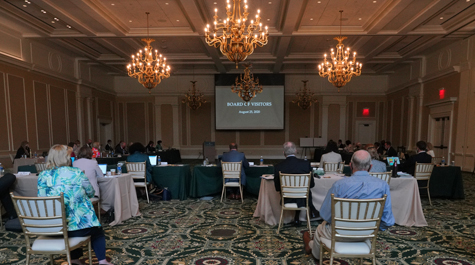W&M responds to call for feedback on naming principles
The William & Mary community responded “emphatically and with a great deal of warmth toward our Alma Mater of a Nation” to principles drafted for naming and renaming of buildings, spaces and structures on campus, according to Warren W. Buck III M.S. '70, Ph.D. '76, D.Sc. ’13.
Speaking to the Board of Visitors Tuesday, Buck said that the university’s Principles of Naming and Renaming Working Group received 220 pages of responses to the 12 draft principles and three design imperatives posted online Aug. 12 for public comment.
Buck, chair of working group and special advisor for equity in the 21st century to President Katherine A. Rowe, said that the responses “ran the full spectrum,” from those who hope renaming will help “demonstrate a multiplicity of histories” on campus to those who “don’t see a rationale for name changes at all.”
“What we will do now is take all of this information that we’ve been gathering and consider it all very carefully and thoughtfully before we submit to President Rowe for the September (24-25) board meeting,” said Buck, adding that the committee also heard feedback that the language describing the principles needs to be revised for a broader audience.
“Part of our work will also be to rewrite the draft principles in plainer language,” Buck added.
Anthony M. Joseph ’21, president of W&M’s Student Assembly and a member of the working group, asked that the group be allowed more time to seek additional feedback from the Black, Indigenous and people of color (BIPOC) population.
“They are the most affected because historically, they were the ones who were disenfranchised,” said Joseph, adding that while academic integrity and acknowledging history matter, the university should balance that with the emotional impact building and space names have, especially on the BIPOC population.
Rector John E. Littel P ’22, on behalf of the Board of Visitors, charged Rowe with establishing the working group, which is made up of administrators, alumni, students, faculty and staff, to draft the principles for naming and renaming buildings, spaces and structures on campus. The group began its work in June. The Board, the university’s governing body, holds ultimate responsibility for the campus landscape, including building names.
“As the alma mater of the nation, W&M has an opportunity, at this moment, to expand the stories we tell of who mattered throughout our history, and why. Over the centuries, practices of naming reflect the inherent biases in what a society or a community deems worthy of remembering,” Rowe said. “By thinking deliberately, and drawing more deeply on our own history, we can diversify who we remember and honor. This work of ‘narrative correction’ is incredibly important now and for the future. So I deeply appreciate the thoughtful efforts of Dr. Buck and the working group. I look forward to their revised set of draft principles.”
Littel thanked Rowe, Buck and the working group for the work underway, and emphasized how it builds on the comprehensive efforts of researchers, scholars and students over the past decade to tell a fuller story about William & Mary’s history, particularly the work of the Lemon Project.
“We have a genuine commitment to reconciliation,” said Littel, citing the research and expertise of the Lemon Project; investments the university has made in scholarships and fellowships; and the self-examination and reflection that resulted from the yearlong commemoration of the 50th anniversary of African American residential students.
“When we have identified things that are inconsistent with our values, we have acted” Littel said. “We have begun and are committed to contextualize those we commemorate, in the spirit expressed by Harvard Professor Annette Gordon-Reed, an honorary degree recipient from William & Mary, to “take the good with the bitter” as we strive to more fully tell the narrative of those who started William & Mary and our country. Notwithstanding that, we are a colonial institution that is central to and interwoven with the founding of our nation. So while we should fully contextualize the founding fathers, it is important that we recognize that there would be no William & Mary, and indeed no United States of America, without these individuals.
“So Chairman Buck and Madame President, we hope you’ll continue to refine your work and seek additional feedback from a broad range of students, faculty and alumni. We look forward to hearing more from you in the future.” Skip to main content
Skip to main content


